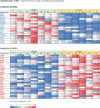Comparative transcriptomic analysis of human mesenchymal stem cells derived from dental pulp and adipose tissues
- PMID: 31239606
- PMCID: PMC6586766
- DOI: 10.46582/jsrm.1501003
Comparative transcriptomic analysis of human mesenchymal stem cells derived from dental pulp and adipose tissues
Abstract
Objective: Mesenchymal stem cells (MSCs) have been isolated from various human tissues. Although they share cardinal stem cell features of self-renewal and multi-potency, they also seem to possess distinct characteristics depending on the tissue types they originated from. When developing stem cell-based therapies, MSCs with the most desirable characteristics should be chosen. However, our knowledge on tissue type-specific characteristics of MSCs is limited. Here, we comparatively studied the gene expression profiles of MSCs from different tissue types, and predicted target diseases suitable for each type of MSCs. Methods: We harvested MSCs from human dental pulp and adipose tissue specimens and subjected them to gene expression microarray analysis. Characteristic gene expression signatures of the MSCs from each tissue type were identified using gene-annotation enrichment analysis. Results: Dental pulp-derived MSCs exhibited gene expression signatures of neuronal growth, while adipose tissue-derived MSCs exhibited signatures of angiogenesis and hair growth. MSCs from each tissue type expressed a discrete set of genes encoding secretory peptides, which may function as paracrine factors. Conclusions: MSCs derived from different tissue types demonstrated distinct gene expression signatures, which are suggestive of target diseases in clinical applications of the MSCs and stem cell-conditioned media. By expanding the analysis to MSCs from a wide range of tissue types, and by employing multiple omics approaches, a catalogue of MSCs and therapeutic targets can be generated.
Keywords: Adipose tissue; Dental pulp; Transcriptome.
Conflict of interest statement
None
Figures
Similar articles
-
Extracellular vesicles from mesenchymal stem cells of dental pulp and adipose tissue display distinct transcriptomic characteristics suggestive of potential therapeutic targets.J Stem Cells Regen Med. 2021 Dec 30;17(2):56-60. doi: 10.46582/jsrm.1702009. eCollection 2021. J Stem Cells Regen Med. 2021. PMID: 35250202 Free PMC article.
-
Unique molecular signatures influencing the biological function and fate of post-natal stem cells isolated from different sources.J Tissue Eng Regen Med. 2015 Dec;9(12):E252-66. doi: 10.1002/term.1663. Epub 2012 Dec 10. J Tissue Eng Regen Med. 2015. PMID: 23229816 Clinical Trial.
-
Comparison of human mesenchymal stem cells derived from dental pulp, bone marrow, adipose tissue, and umbilical cord tissue by gene expression.Biomed Pap Med Fac Univ Palacky Olomouc Czech Repub. 2014 Sep;158(3):373-7. doi: 10.5507/bp.2013.078. Epub 2013 Oct 18. Biomed Pap Med Fac Univ Palacky Olomouc Czech Repub. 2014. PMID: 24145770
-
Umbilical cord mesenchymal stem cells: the new gold standard for mesenchymal stem cell-based therapies?Tissue Eng Part B Rev. 2014 Oct;20(5):523-44. doi: 10.1089/ten.TEB.2013.0664. Epub 2014 Apr 22. Tissue Eng Part B Rev. 2014. PMID: 24552279 Review.
-
Pulp-dentin Regeneration: Current State and Future Prospects.J Dent Res. 2015 Nov;94(11):1544-51. doi: 10.1177/0022034515601658. Epub 2015 Aug 26. J Dent Res. 2015. PMID: 26310721 Review.
Cited by
-
Bovine-Derived Xenografts Immobilized With Cryopreserved Stem Cells From Human Adipose and Dental Pulp Tissues Promote Bone Regeneration: A Radiographic and Histological Study.Front Bioeng Biotechnol. 2021 Apr 12;9:646690. doi: 10.3389/fbioe.2021.646690. eCollection 2021. Front Bioeng Biotechnol. 2021. PMID: 33912548 Free PMC article.
-
Extracellular vesicles from mesenchymal stem cells of dental pulp and adipose tissue display distinct transcriptomic characteristics suggestive of potential therapeutic targets.J Stem Cells Regen Med. 2021 Dec 30;17(2):56-60. doi: 10.46582/jsrm.1702009. eCollection 2021. J Stem Cells Regen Med. 2021. PMID: 35250202 Free PMC article.
-
Identifying Biomarkers for Osteogenic Potency Assay Development.Adv Exp Med Biol. 2023;1420:39-58. doi: 10.1007/978-3-031-30040-0_4. Adv Exp Med Biol. 2023. PMID: 37258783
-
Liver mesenchymal stem cells are superior inhibitors of NK cell functions through differences in their secretome compared to other mesenchymal stem cells.Front Immunol. 2022 Sep 21;13:952262. doi: 10.3389/fimmu.2022.952262. eCollection 2022. Front Immunol. 2022. PMID: 36211345 Free PMC article.
-
Mesenchymal stem/stromal cell-based therapy: mechanism, systemic safety and biodistribution for precision clinical applications.J Biomed Sci. 2021 Apr 14;28(1):28. doi: 10.1186/s12929-021-00725-7. J Biomed Sci. 2021. PMID: 33849537 Free PMC article. Review.
References
-
- Terunuma H, Ashiba K, Terunuma A, Deng X, Watanabe K. Conditioned medium of human immortalized mesenchymal stem cells as a novel therapeutic tool to repair damaged tissues. J Neurosci Neuroeng. 2015;4:9–12.
-
- Ruppert KA, Nguyen TT, Prabhakara KS, Toledano Furman NE, Srivastava AK, Harting MT, Cox CS, Jr, Olson SD. Human mesenchymal stromal cell-derived extracellular vesicles modify microglial response and improve clinical outcomes in experimental spinal cord injury. Sci Rep. 2018;8(1):480–91. - PMC - PubMed
-
- Jarocha D, Milczarek O, Wedrychowicz A, Kwiatkowski S, Majka M. Continuous improvement after multiple mesenchymal stem cell transplantations in a patient with complete spinal cord injury. Cell Transplant. 2015;24(4):661–72. - PubMed
LinkOut - more resources
Full Text Sources



